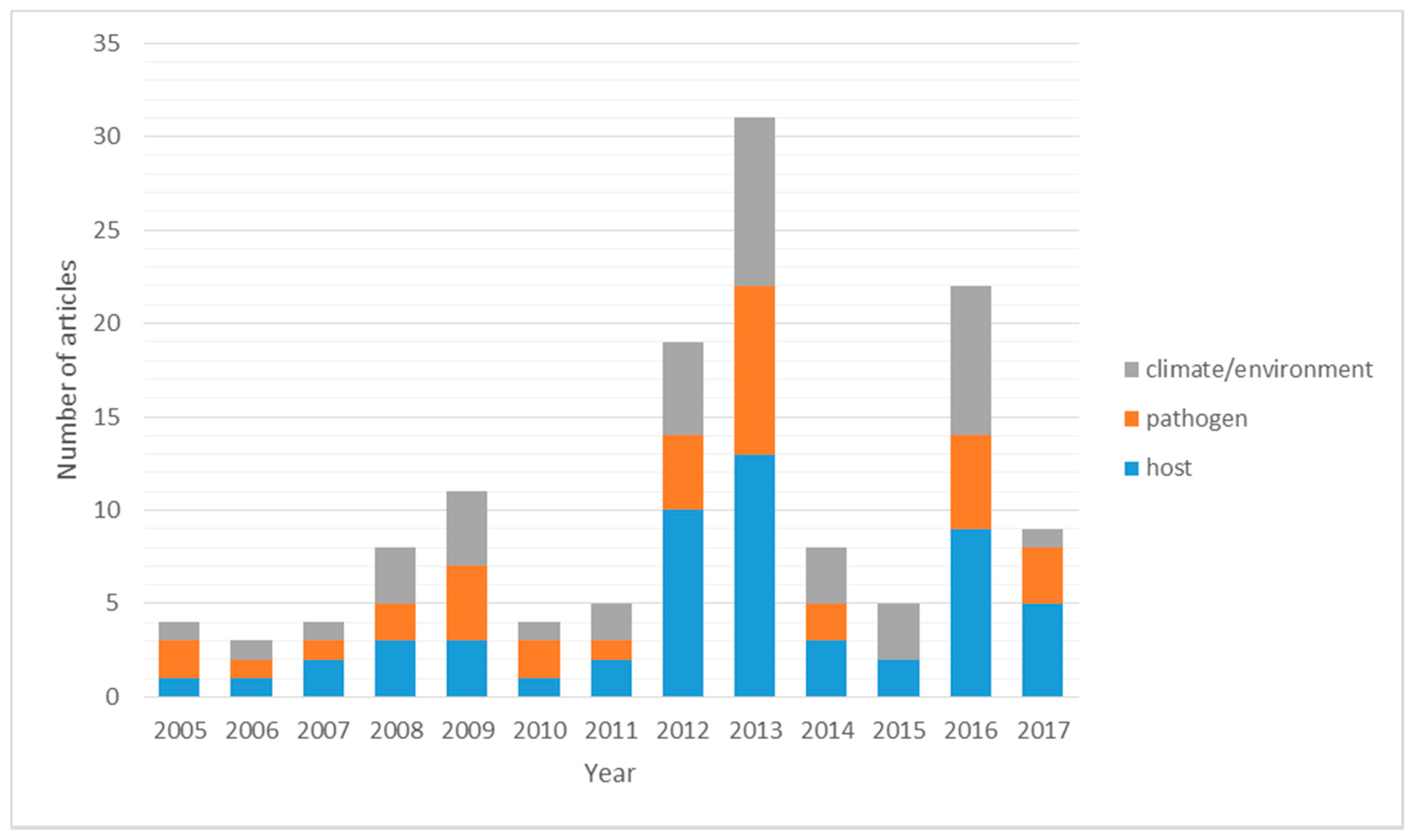Variability and Disturbances as Key Factors in Forest Pathology and Plant Health Studies
Abstract
:Acknowledgments
Author Contributions
Conflicts of Interest
References
- Agrios, G. Plant Pathology, 5th ed.; Academic Press: New York, NY, USA, 2005. [Google Scholar]
- Yun, L.; Zeger, S.L. On the equivalence of case-crossover and time series methods in environmental epidemiology. Biostatistics 2006, 8, 337–344. [Google Scholar]
- Roche, B.; Guégan, J.-F.; Bousquet, F. Multi-agent systems in epidemiology: A first step for computational biology in the study of vector-borne disease transmission. BMC Bioinform. 2008, 9, 435. [Google Scholar] [CrossRef] [PubMed]
- Desprez-Loustau, M.-L.; Aguayo, J.; Dutech, C.; Hayden, K.J.; Husson, C.; Jakushkin, B.; Marçais, B.; Piou, D.; Robin, C.; Vacher, C. An evolutionary ecology perspective to address forest pathology challenges of today and tomorrow. Ann. For. Sci. 2016, 73, 45–67. [Google Scholar] [CrossRef]
- Pautasso, M.; Doring, T.; Garbelotto, M.; Pellis, L.; Jeger, M. Impacts of climate change on plant diseases—Opinions and trends. Eur. J. Plant Pathol. 2012, 133, 295–313. [Google Scholar] [CrossRef] [Green Version]
- Scholthof, K.G. The disease triangle: Pathogens, the environment and society. Nat. Rev. Microbiol. 2007, 5, 152–156. [Google Scholar] [CrossRef] [PubMed]
- Cobb, R.C.; Metz, M.R. Tree diseases as a cause and consequence of interacting forest disturbances. Forests 2017, 8, 147. [Google Scholar] [CrossRef]
- Parker, I.M.; Gilbert, G.S. The evolutionary ecology of novel plant-pathogen interactions. Annu. Rev. Ecol. Evol. Syst. 2004, 35, 675–700. [Google Scholar] [CrossRef]
- Oliva, J.; Boberg, J.; Hopkins, A.J.M.; Stenlid, J. Concepts of epidemiology of forest diseases. In Infectious Forest Diseases; Gonthier, P., Nicolotti, G., Eds.; CABI: Wallingford, UK, 2013; pp. 1–28. [Google Scholar]
- Soularue, J.-P.; Robin, C.; Desprez-Loustau, M.-L.; Dutech, C. Short rotations in forest plantations accelerate virulence evolution in root-rot pathogenic fungi. Forests 2017, 8, 205. [Google Scholar] [CrossRef]
- Munck, I.A.; Luther, T.; Wyka, S.; Keirstead, D.; McCracken, K.; Ostrofsky, W.; Searles, W.; Lombard, K.; Weimer, J.; Allen, B. Soil and stocking effects on Caliciopsis canker of Pinus strobus L. Forests 2016, 7, 269. [Google Scholar] [CrossRef]
- Ortíz de Urbina, E.; Mesanza, N.; Aragonés, A.; Raposo, R.; Elvira-Recuenco, M.; Boqué, R.; Patten, C.; Aitken, J.; Iturritxa, E. Emerging needle blight diseases in Atlantic Pinus ecosystems of Spain. Forests 2017, 8, 18. [Google Scholar] [CrossRef]
- Thomas, C.D. Climate, climate change and range boundaries. Div. Distr. 2010, 16, 488–495. [Google Scholar] [CrossRef]
- Kubiak, K.; Żółciak, A.; Damszel, M.; Lech, P.; Sierota, Z. Armillaria pathogenesis under climate changes. Forests 2017, 8, 100. [Google Scholar] [CrossRef]
- Panzavolta, T.; Panichi, A.; Bracalini, M.; Croci, F.; Ginetti, B.; Ragazzi, A.; Tiberi, R.; Moricca, S. Dispersal and propagule pressure of Botryosphaeriaceae species in a declining oak stand is affected by insect vectors. Forests 2017, 8, 228. [Google Scholar] [CrossRef]
- Holdenrieder, O.; Pautasso, M.; Weisberg, P.J.; Lonsdale, D. Tree diseases and landscape processes: The challenge of landscape pathology. Trends Ecol. Evol. 2004, 19, 446–452. [Google Scholar]
- Lione, G.; Gonthier, P.; Garbelotto, M. Environmental factors driving the recovery of bay laurels from Phytophthora ramorum infections: An application of numerical ecology to citizen science. Forests 2017, 8, 293. [Google Scholar] [CrossRef]
- Laine, A.L.; Burdon, J.J.; Dodds, P.N.; Thrall, P.H. Spatial variation in disease resistance: From molecules to metapopulations. J. Ecol. 2011, 99, 96–112. [Google Scholar] [CrossRef] [PubMed]
- Ruiz Silva, R.; Costa da Silva, A.; Antônio Rodella, R.; Eduardo Serrão, J.; Cola Zanuncio, J.; Luiz Furtado, E. Pre-infection stages of Austropuccinia psidii in the epidermis of eucalyptus hybrid leaves with different resistance levels. Forests 2017, 8, 362. [Google Scholar] [CrossRef]
- Chieppa, J.; Eckhardt, L.; Chappelka, A. Simulated summer rainfall variability effects on loblolly pine (Pinus taeda) seedling physiology and susceptibility to root-infecting ophiostomatoid fungi. Forests 2017, 8, 104. [Google Scholar] [CrossRef]
- Gilbert, G.S. Evolutionary ecology of plant diseases in natural ecosystems. Annu. Rev. Phytopathol. 2002, 40, 13–43. [Google Scholar] [CrossRef] [PubMed]
- Danti, R.; Della Rocca, G. Epidemiological history of Cypress Canker Disease in source and invasion sites. Forests 2017, 8, 121. [Google Scholar] [CrossRef]
- Ploetz, R.C.; Kendra, P.E.; Choudhury, R.A.; Rollins, J.A.; Campbell, A.; Garrett, K.; Hughes, M.; Dreaden, T. Laurel wilt in natural and agricultural ecosystems: understanding the drivers and scales of complex pathosystems. Forests 2017, 8, 48. [Google Scholar] [CrossRef]
- Mehl, J.; Wingfield, M.J.; Roux, J.; Slippers, B. Invasive everywhere? Phylogeographic analysis of the globally distributed tree pathogen Lasiodiplodia theobromae. Forests 2017, 8, 145. [Google Scholar] [CrossRef]

© 2017 by the authors. Licensee MDPI, Basel, Switzerland. This article is an open access article distributed under the terms and conditions of the Creative Commons Attribution (CC BY) license (http://creativecommons.org/licenses/by/4.0/).
Share and Cite
Garbelotto, M.; Gonthier, P. Variability and Disturbances as Key Factors in Forest Pathology and Plant Health Studies. Forests 2017, 8, 441. https://doi.org/10.3390/f8110441
Garbelotto M, Gonthier P. Variability and Disturbances as Key Factors in Forest Pathology and Plant Health Studies. Forests. 2017; 8(11):441. https://doi.org/10.3390/f8110441
Chicago/Turabian StyleGarbelotto, Matteo, and Paolo Gonthier. 2017. "Variability and Disturbances as Key Factors in Forest Pathology and Plant Health Studies" Forests 8, no. 11: 441. https://doi.org/10.3390/f8110441




